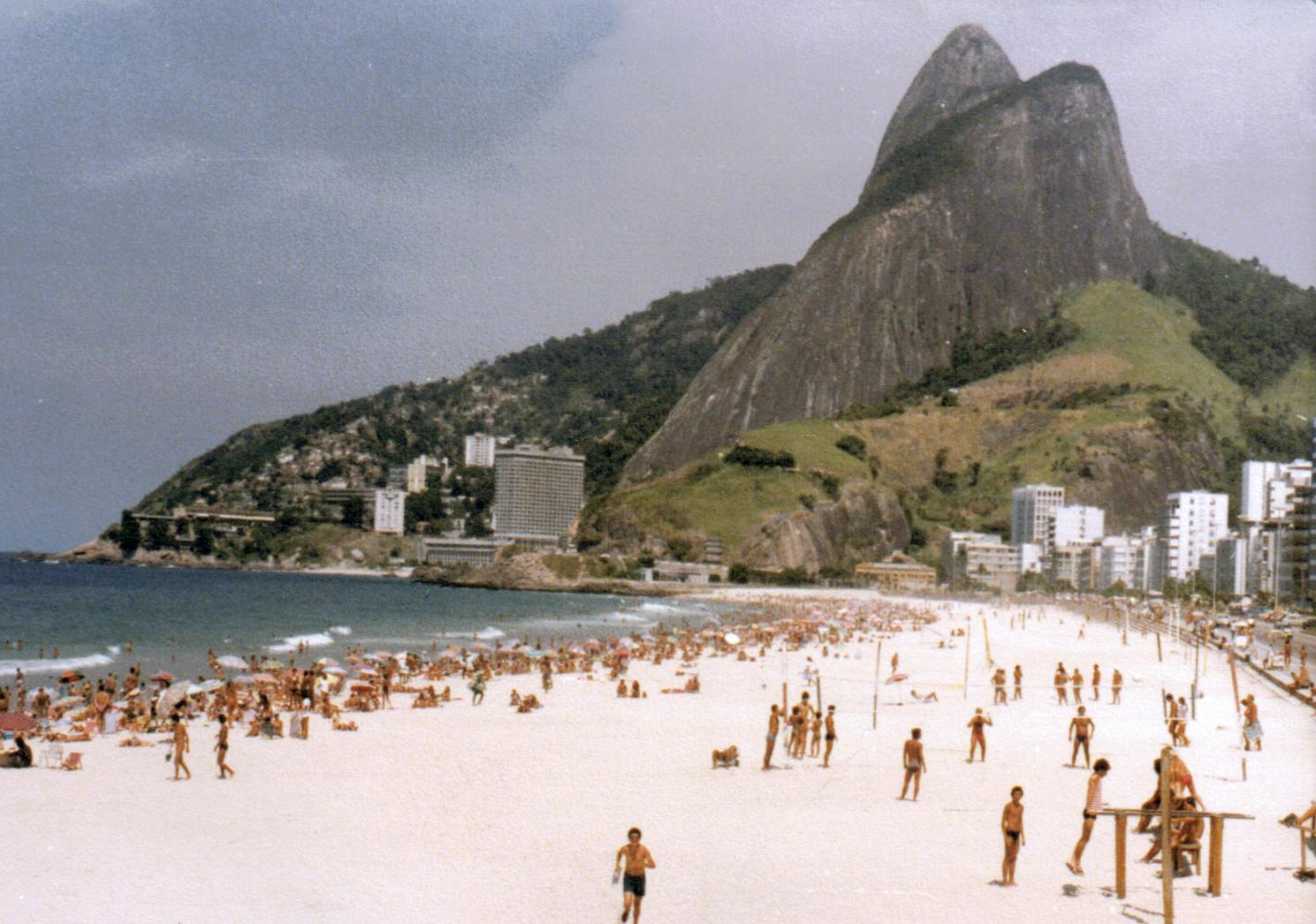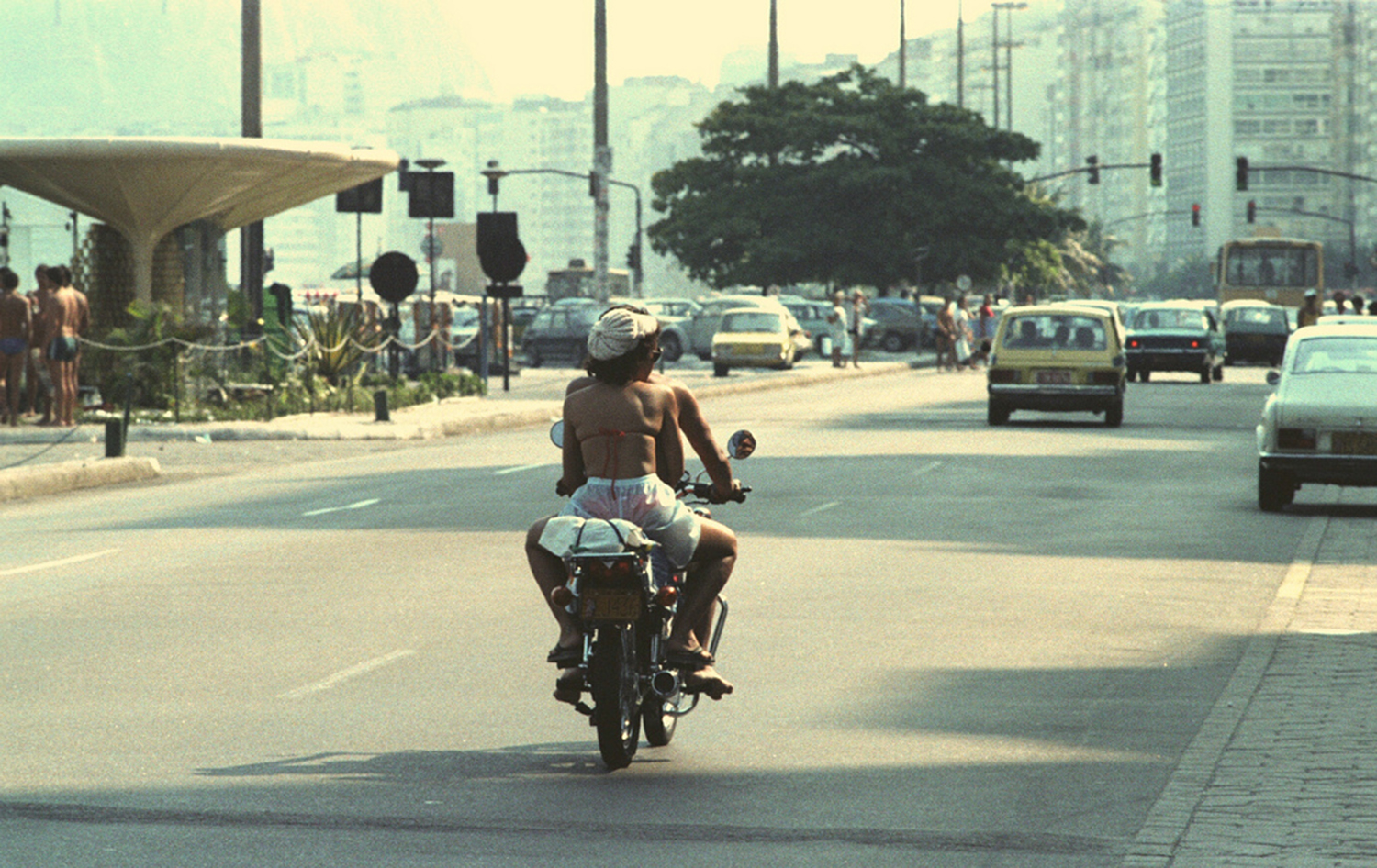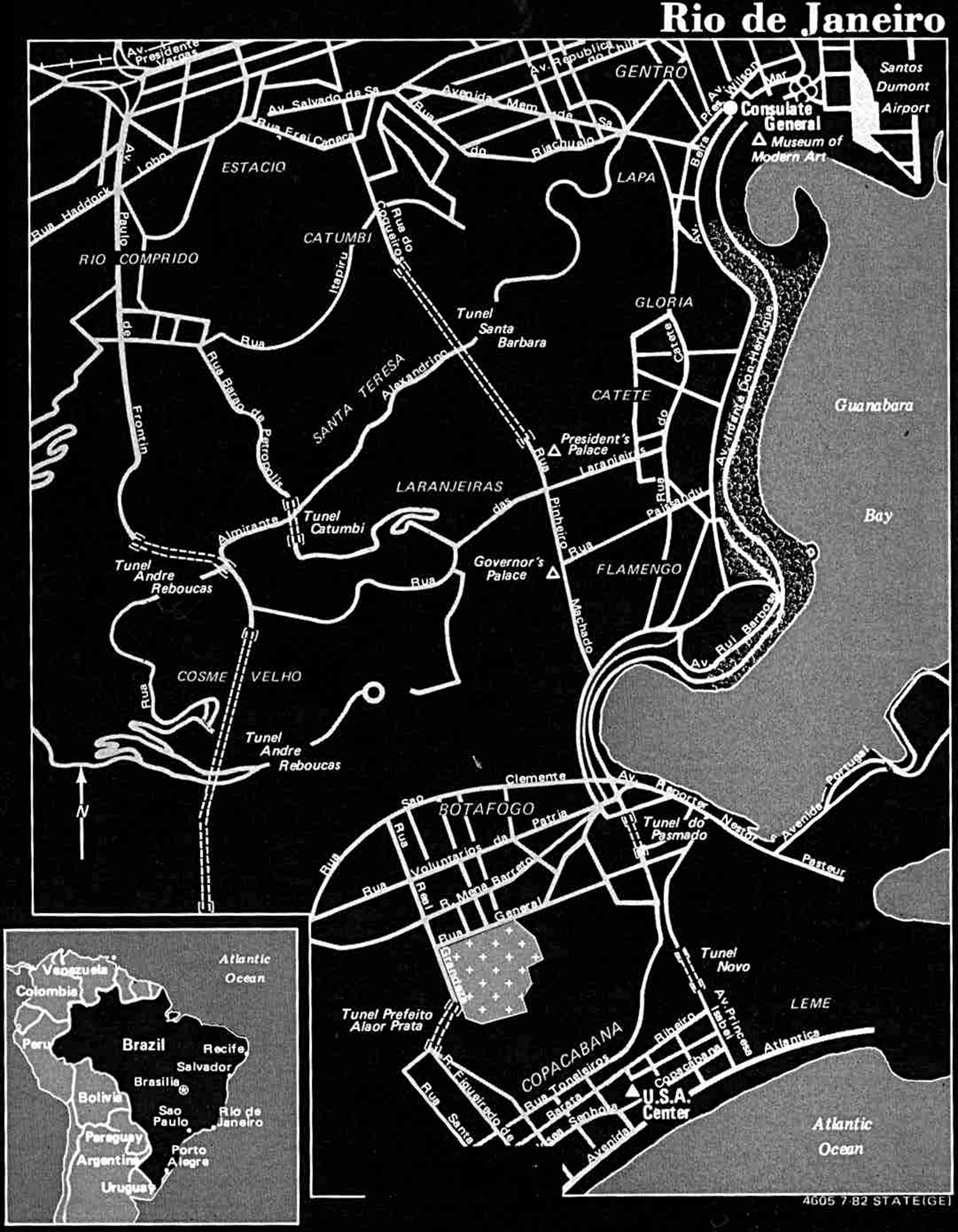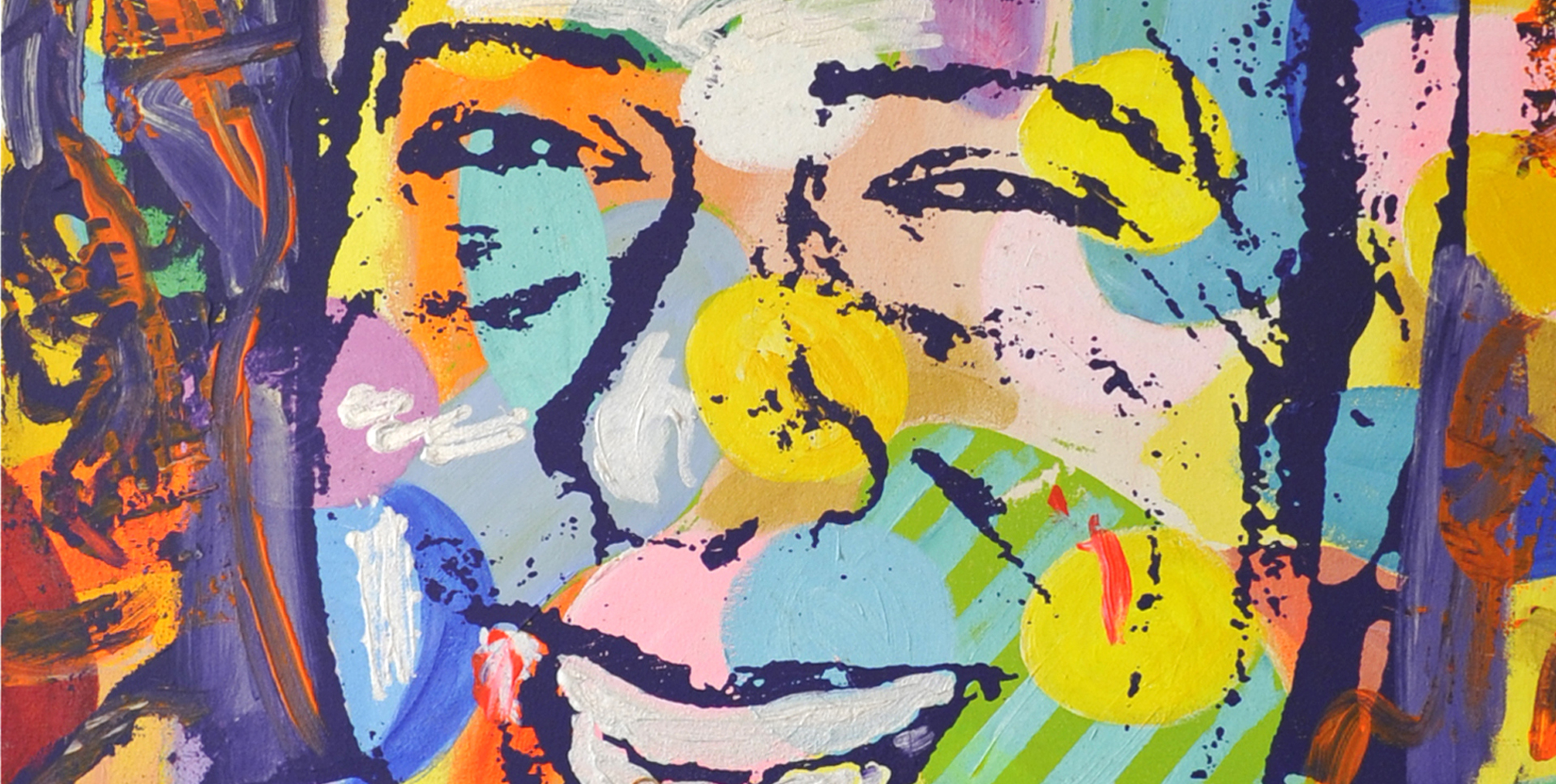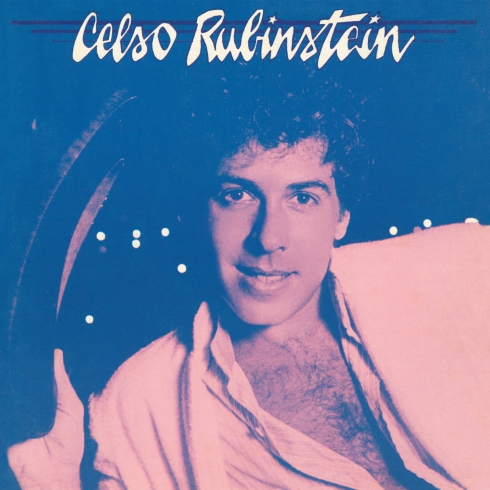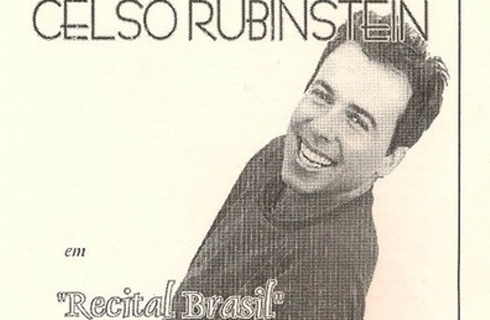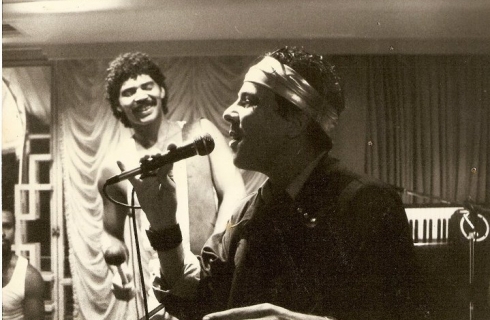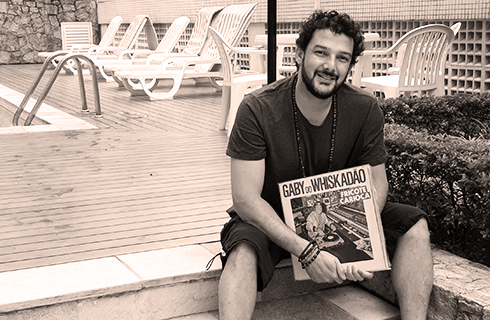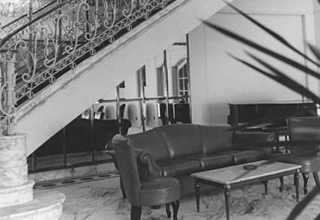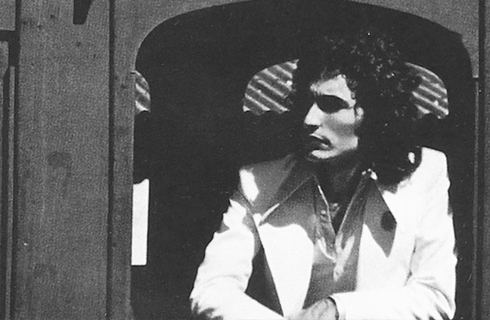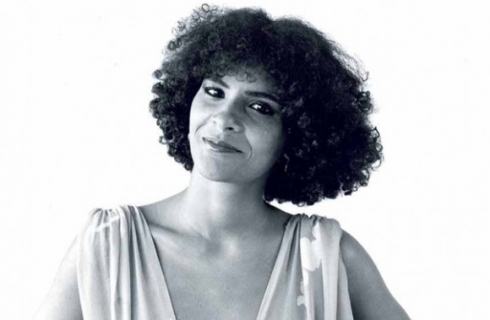NOAJ7-001
Celso Rubinstein —
É A Vida Que Diz / Enquanto Houver
Born in Brazil to a family of Holocaust survivors, Celso Rubinstein’s career as a singer allowed him to take residency in several countries including Spain, Portugal, Israel and Britain. He performed as an artist in numerous clubs and supported other artists as backing vocalist. In 1982 he booked studio time at Chico Batera’s studio in Rio De Janeiro to record two songs for an intentional debut album.
Buy NowTracklisting
- A — É A Vida Que Diz
(Marina Lima, Antonio Cicero)
- B — Enquanto Houver
(Paulinho Mendonca, Gerson Conrad)
Credits
- Chico Batera — Drums, Percussion
Reynaldo Arias — Keys, Moog
Ricky Pantoja — Oberheim
Claudio Stevenson — Guitar
Don — Flugelhorn, Piston
Oberdan — Alt sax
Fernando Alves — Bass - Recorded at Chico Batera’s Studio, Rio De Janeiro, Brasil in 1981/82.
- Re-mastered from original vinyl by Oliver Haertel at Upstairs Studio Berlin.
Liner Notes —
With the fifth release and the first 7inch, we turn our attention to Brazil.
Finally, one might think, since it’s an open secret that the guys behind the label all have a soft spot for music from the leading coffee exporter in the world. So, when Brazilian DJ, record collector and digger extraordinaire Junior Santos brought this Celso Rubinstein 7-inch EP (called «Compacto» in Brazil) to the Berlin label’s attention he hadn’t to do a lot of persuading to have NOAJ reintroduce this beautiful piece of music to fans around the world some 36 years after its first appearance. Born in Brazil to a family of Holocaust survivors, Celso Rubinstein’s career as a singer allowed him to take residency in several countries including Spain, Portugal, Israel and Britain. He performed as an artist in numerous clubs and supported other artists as backing vocalist. In 1982 he booked studio time at Chico Batera’s studio in Rio De Janeiro to record two songs for an intentional debut album.
On «Enquanto Houver», written by Paulinho Mendonça and Gerson Conrad, Rubinstein tried to infuse some rap flavour: «I wanted to get away from that style of singing where you sing a bunch of notes without breathing. You can hear that all the words in the song are pronounced properly but the cadence is broken up, so the intention was to do a kind of rap without it seeming to be rap.» Marina Lima and Antonio Cicero contributed «È A Vida Que Diz», a song as marvelously written as much as performed sophisticatedly by Rubinstein with his star-studded studio crew. Amongst them: Oberdan Magalhães and Claudio Stevenson from Banda Black Rio, Rique Pantoja, keyboard player, arranger and conductor Reinaldo Arias, as well as American session musician Don Harris. Celso Rubinstein wanted to create a unique atmosphere for the recording sessions, inviting numerous people to the control room to amplify the spontaneous live feeling even more (the control room was filled with people like Ney Matogrosso, As Frenéticas, Claudia Telles, Fátima Guedes.) You definitely can hear this vitality on the record originally published in 1982 by Rubinstein himself. Since there was a massive vinyl shortage at the time in Brazil, no label had any spare material to waste on newcomers. Only the label Tapecar, which had its own pressing plant, helped Rubinstein out and used the left over material from the manufacture of Gal Costa’s latest album («Minha Voz») to have his 7” privately pressed. Needless to say that it missed any recognition back then. But now, 36 years later, thanks to Junior Santos and Notes On A Journey a broad audience has the joy to finally embrace this beautiful music wholeheartedly.
Interview —
The following interview not only gives a detailed insight into Celso Rubinstein’s career so far but also points to Celso’s interview partner, Junior Santos.
Also Brazilian, Santos is a true expert in the Brazilian music genre who also journeyed to Europe to work as a musician only some 30 years later. Check out his compilation Brazilian Disco Boogie Sounds (1978-1982) on Favorite Recordings. Aside from being a drummer, record collector, and DJ, he also introduced the Notes On A Journey crew to this Celso Rubinstein 7-inch EP, called “Compacto” in Brazil, which we are now so proud to reintroduce to fans around the world some 36 years after its first appearance. The interview was conducted in Portuguese and transcribed by Junior Santos. The English translation was done by Greg Caz who is well known for his two compilation projects “The Brazilian Boogie Connection” and “The Brasileiro Treasure Box Of Funk & Soul”, both released on the “Cultures Of Soul” label. Further more, he is Djing weekly at Nublu in Manhattan and monthly at Our Wicked Lady in Brooklyn. Thank both of you so much.
Skype INTERVIEW between the two artists and musicians CELSO RUBINSTEIN (CR) and JUNIOR SANTOS (JS) recorded during December 2017:
JS: We’re here with Celso Rubinstein, a great artist and a great figure in Brazilian music. A guy with a lot of stories to tell us. We’re going to be discussing Celso’s 1982 self released 7 Inch which only has two songs but has a fabulous history behind it. Celso, I’d like to start by asking you to talk a bit about the start of your career, how old were you when you started singing, and when did you turn professional, singing in clubs? You started young, didn’t you? In the 1960s, when you were living in Copacabana in Rio De Janeiro, right?
CR:I was 14 to 15 years old, when I started to sing in clubs. That was during the 1960s, when I was growing up in Copacabana, Rio De Janeiro. There were child labor laws being enforced at that time, and the weird thing was that I looked about 17-18 but was only 14-15. As time went on I started to become like Dorian Grey, looking younger and younger and getting older and older! I had papers signed by my parents allowing me to perform. My first gig was at the Bierklaus, a club in Copacabana. It was an incredible place where lots of artists like Djavan and Alcione performed early in their careers before they ever recorded. They performed at peak hour at the club, 10PM and later. I performed earlier, from around 5PM in the afternoon to about 7PM. I managed to get this gig through Booker Pittman (Eliana Pittman’s stepfather), who knew the Bierklaus’ owner. The man known as the “King Of The Rio Night,” Alberico Campana, was also a partner at the Bierklaus. Soon after this my parents moved to Tel Aviv as a sort of “experiment” to see what living there was like. Since I was still a minor I had to go with them. I lived there for three years and found a jazz club called Bar Barim (The Barbarians) where I met an Israeli jazz drummer who was crazy about and completely obsessed with Brazilian music. As soon as he met me he invited me to sing, saying, “Let’s go!” And I didn’t have to say or explain anything, just call out the names of the songs which were basically Bossa Nova. At the time what we now know as “MPB” was only starting to emerge and consolidate itself so the repertoire was largely still Bossa. I myself had a lot of jazz influence, I was doing a kind of fusion of Bossa-Jazz and was really influenced by Sergio Mendes & Brasil ’66. All this was my laboratory while putting together a repertoire, especially being away from Brazil, which allowed me even more of a universal eclecticism.
JS: What was the format of the band backing you up, was it a trio, a quartet?
CR: Well, because I was freshly arrived in Israel without much knowledge of anything, that was my first gig, in that jazz club, with the drummer Arale Kaminsky. Soon after I met two more Brazilians, the flute player Paulo Naitim and the guitarist Jacques Purim, Flora’s brother. We ended up forming a trio and needed a drummer so we called Arale Kaminsky. When I heard that Radio Israel was putting together a music festival comprised of immigrant musicians singing in their own language, I sent two songs: Jorge Ben’s “País Tropical” and “Viola Enluarada” by Marcos and Paulo Sérgio Valle. We recorded those in sort of improvised fashion at the radio station’s own studio and there wasn’t much in terms of equipment because Israel was brand-new, barely 20 years old. So we recorded these songs in a very precarious way. The rules only allowed one song per artist but we got both songs in. It was a chance to show some versatility on my part, to sing a very somber song like “Viola Enluarada” and then a really upbeat one like “País Tropical.”
CR: From Israel I went to live in England, I didn’t go back to Brazil right away, we went there first. In 1973 the Yom Kippur War had started in Israel and because my status was that of a temporary resident I would either have to become a permanent resident and go fight in that war, or I would have to leave the country. My parents didn’t have much, shall we say, “affinity” for war because they were WWII survivors, so they sent me to England.
JS: They were Jewish, right?
CR: Yes. So, arriving in the UK I started going to pubs and venues like the Marquee which was a sort of rock temple at the time. It wasn’t really my style but I loved going there anyway. That was until I found places that played Bossa Nova and jazz, and I could get to sing a few Brazilian and jazz standards. I would sing the A part of the songs in English and the B part in Portuguese or vice versa. I was doing that fusion during the three years I lived in England, then I returned to Brazil.
JS: But you returned to Europe later, didn’t you?
CR: Yes, in the 80s.
JS: Let’s talk a bit about your glorious times at the Baiúca Roosevelt.
CR: So, when I returned from England to Brazil I went straight to Rio, this was in 1975-76. I was working in Rio clubs at night and suddenly started to find Rio a bit small and stifling. I was singing at People, at Mistura Fina, at Jazz Mania, but it was just those three. Since the big boom in Brazilian musical nightlife during that period was happening in São Paulo I decided to go there. When I arrived, I kind of “chose” the Baiúca and that was the first door I knocked on. This might sound a bit pretentious because the Baiúca was a really important place with a deep tradition and it had existed for more than 40 years already at that point. It was where so many legends got their performing start, people like Dick Farney, Johnny Alf, Cauby Peixoto and people like that. When I went in there the first time the guy performing was Dave Gordon from Georgetown, ex-British Guyana, an incredible singer. That night I also met the Baiúca’s owner, Aristides.
JS: This was towards the end of the 70s?
CR: Yes, and that same night I did a guest spot singing a Maysa song. I was in my early 20s and that song had been recorded in the 50s but here I was with a Rio accent singing for a São Paulo public and that club was frequented by a very upscale crowd, people from important São Paulo families like the Scarpa family, the Matarazzo family, the Abdala family, a very refined crowd. So when they saw and heard me, this young kid with a Carioca accent singing a 50s Maysa song it really caught their attention. I got a regular gig at the Baiúca but I asked for permission to sing in other places as well so I could establish myself around SP and not just be associated with one spot. So I started to also perform at The Gallery (owned by Vitor Oliva), at Giancarlo Bolla’s legendary Village club and at Celso Matsuda’s Via Brasil which was also really popular. And I loved all this, loved this career. There were nights where I would leave one club, hop in a taxi and the doorman at the next club would be waiting for me at the door with the microphone in his hand because it was time for my set, every singer had a certain time they had to go on and I would sometimes be a few minutes late and the bouncer would be waiting right there to hand me the mic so I could walk in already singing! (laughs)
JS: Celso, I’d like for you to talk a bit about something we both have in common, which is having the experience of being a Brazilian musician in Europe, even though we’ve gone through it in different eras, and you’re a vocalist and I’m an instrumentalist. There was a different reality back then, where Ary Barroso, Villa-Lobos, Tom Jobim and Bossa Nova opened doors for all of us, and Sergio Mendes whom you just mentioned did as well. I’d like you to talk a little bit about that, how it was for you, your life and musical apprenticeship as a Brazilian musician here in Europe, then I’ll talk a bit about mine as well.
CR: Well, just so we can pinpoint the exact timeline, I spent 21 non-continuous years outside Brazil, a lot of comings and goings. I’ll tell you what personally helped me: I never needed to come up with a stage name, the name on my birth certificate is Celso Rubinstein but the “Rubinstein” caught people’s attention for two reasons: one, the biggest name in cosmetics was Helena Rubinstein. There were billboards advertising her products all over. And two, of course we know about Artur Rubinstein who is a major entity in classical music! And Celso is a really Brazilian name because my parents didn’t want to name me Moses or Jacob or Isaac because they knew we were going to be living in Brazil so I had to have a really Brazilian-sounding name. My first performance contract in Madrid was at the Hotel Castellana Intercontinental where they presented a season of Brazilian music in their garden in the winter, it was really beautiful and elegant. I was singing with a pianist who was playing a grand piano. When the picture of me standing next to this guy playing a grand piano appeared in the El País newspaper it gave the impression of being a classical recital and on opening night it was completely sold out, the entire diplomatic corps of Madrid reserved seats at the hotel because they thought it was gonna be classical music.
JS: We were talking before the interview about Marcia Maria, who sang at the inauguration of that hotel if I’m not mistaken.
CR: I remember her really well, she’s an amazing singer. She’s from the Peixoto family, isn’t she?
JS: Yes, she’s Cauby Peixoto’s cousin, her full name is Marcia Maria Peixoto.
CR: There was also a trumpet player on São Paulo’s nighttime scene who was a fan of mine, and I loved him too: Araken Peixoto, Cauby’s brother.
JS: I played with Marcia for a long time. When I moved to Paris from Lisbon I lived at her house for a while. She gave me a lot of support and help during a difficult period in my life. She also has a story quite similar to yours, she sang in all those places you also sang in. She was close friends with the bassist Luizão Maia, they’d go back and forth to São Paulo every weekend and their friendship lasted until the end, when he was living in Japan. Myself, I believe that this school of nighttime dance bands were for my generation of the early 90s as were the “Conjuntos” for your generation. São Paulo and Rio had a tradition of clubs with live bands, and smaller towns had the “Baile” bands. All that was a great school to learn improvisation, learning songs by ear, playing as a band, learning different musical genres and grooves, etc.
JS: How do you view the acceptance of Brazilian music in those days? How was your struggle in those days which were much different than it is for a Brazilian musician just arriving in Europe today?
CR: I believe that was a more receptive time period. There was more communication, I think because of RAI, the Italian TV network. There were special programs with Elis Regina, Wilson Simonal, people like that, you know? Ornella Vanoni made that famous album with Vinicius de Moraes and Toquinho. In France there was the Nouvelle Vague film movement, there was Pierre Barouh who had his own label called SARAVAH recording Bossa Nova songs in French, there was this whole exchange with Brazilian music.
CR: Junior, the big difference with you is yourself, because your musical and cultural baggage is something few European musicians of your age group have. That’s what sets us apart. Because, aside from my own career, I did backing vocals for a lot of artists on RCA like Eliana Pittman and Sidney Magal among others who I can’t even remember at this point, my memory’s failing me these days! (laughs)
JS: Celso, can you tell me about your experience here in Europe, what did you bring here, and what did you take away?
CR: There were phases, like when I came the last time, I had my work, a solo career, a video, my single, posters and whatnot so it was “easier” to work continuously. This is important because the “breaks” are harder to come by in Brazil. You can continue living your life when there are no gigs in Brazil. In Europe things are run more within a certain establishment so I always had work, usually in hotels if not jazz clubs. For example there was a night club called Café Berlin in Madrid, a jazz place, where the best musicians in Europe played. I was a house musician there for many years, they had a place in the basement dedicated solely to Brazilian music that was called Oba-Oba. I would sing jazz upstairs and then go downstairs to sing danceable Brazilian music, stuff like Tim Maia, Gilberto Gil, Jorge Ben, etc. It was a really good experience, I learned a lot from musicians from around the world. I loved flamenco, I met Paco De Lucia and all sorts of great flamenco dancers as well. I really believe those years in Europe were a great “school” for me.
JS: Let’s talk a little bit about your 7 inch. tell us about how the opportunity to record it came about. We know that there were more takes that were recorded but which got lost in the mists of time and that it was originally intended to be a full LP. Tell me a little bit about the making of it.
CR: It was a funny moment, it was kind of a laboratory. When Paulinho Mendonça and Gerson Conrad brought me “Enquanto Houver” I listened to it and wanted to give it my own interpretation. I wanted to give it a bit of a rap flavor but there wasn’t really rap in Brazil yet at the time, there was American funk which was a similar thing but not exactly what I wanted. I wanted to get away from that style of singing where you sing a bunch of notes without breathing. I wanted to show off my voice and also pronounce all the words properly. You can hear that all the words in the song are pronounced properly but the cadence is broken up, so the intention was to do a kind of rap without it seeming to be rap. Then when Marina Lima and Antonio Cícero brought me “A Vida É Que Diz” I loved it, it reminded me a bit of Billie Holiday because it had a lot of short notes, like in a lot of Billie’s work, because she had a short range but you still felt her power. She knew how to use what she had. My own vocal conception was to sing longer notes, which was more comfortable for me, and this thing with singing shorter notes was a little bit of a challenge for me but I enjoyed doing it.
JS: What was the behind-the-scenes story behind the record? You told me it was all done live with all the musicians playing together, and there was Don Harris on it as well.
CR: It was really cool to record that way because Chico Batera and I were like brothers even outside of music and I told him “Chico, I want to do something I don’t see happen much anymore, a live-in-studio recording. It’s kind of cold the way they make records now, impersonal, everyone tracks their part separately and sometimes they never even see each other. I want to get all these people together with me and you and invite people to the control room to watch us record!” (laughs) He looked at me with that look of his and that trademark laugh and said “OK, let’s do it!” So that was what triggered the possibility of that session happening the way it did. It was a party, just imagine all those people in the studio watching the recording and they were all characters which created an incredible vibe in there. The control room was filled with people like Ney Matogrosso, As Frenéticas, Claudia Telles, Fátima Guedes, hey, I get along with everybody (laughs)…
JS: Look at that, that was the public watching you record! Don Harris is on the record too, playing fluegelhorn, right?
CR: Yeah, he happened to be in Rio, he had just started dating Lelete Pantoja, who was in that female pop-rock band Sempre Livre with Dulce Quental. He actually started living in Rio, around the time of the first festival that James Taylor performed at, so he just stuck around. They got married later on. But I had met him before that at Lelete’s house. She introduced him to me as her boyfriend, saying he played trumpet and fluegelhorn and was in James Taylor’s band. That was exactly when we were putting my recording session together with Chico Batera so I asked him if he’s come down and play an intro or solo on my record and he said sure and he came to the session. Sempre Livre had a song on the charts at the time called “Sou Free” and it was just a great moment all around, a lot of fun, none of the tension and stress that often goes with recording, quite the opposite.
JS: That’s really cool, plus everybody playing together old school-style, right? 1, 2, 3 and off we go. On this single there’s also the late Oberdan Magalhães and Claudio Stevenson from Banda Black Rio and also Reinaldo Arias from Simone’s band.
CR: Yes, he was Simone’s musical director at the time.
JS: The great Rique Pantoja was there too, right?
CR: Yes, him too, he was always down for the cause because we were like family. No musical differences, no jealousy, nothing like that at all, we were really close.
JS: So the whole production was done in a week, right?
CR: Yes, and Cazuza was recording with his band Barão Vermelho in Chico’s studio and we’d run into each other and he saw all the madness at my session, all those people, so he came and checked it out and added his face to everybody else in the “aquarium” (laughs).
JS: You said there was another strange and interesting fact about the pressing of the single that you wanted to talk about, what was that?
CR: At that time there was a vinyl shortage in the country, the stocks of the actual vinyl substance for pressing records were really low. So I went to the Tapecar label because I knew Zezinho Rozenblit, to use their pressing plant. I have a pretty sharp ear and I said that I found the sound of the record to be kind of muffled and compressed. They told me that due to the vinyl shortage they were pressing Gal Costa’s new LP (“Minha Voz”) at Tapecar, something like 500,000 copies. And they used the leftover scraps of vinyl from that to press my single on.
JS: But Gal’s album was on Philips, right?
CR: Yeah, but because of the vinyl shortage and the lack of raw materials the labels had to cooperate with each other to get the maximum amount from whatever vinyl stock was available.
JS: So how do you feel now that your single is being reissued by Notes On A Journey Recordings? How did you react when you first got the news that this was happening?
CR: My first instinct is to answer that with a [Caetano Veloso] song lyric: “Undaunted like Muhammad Ali”! Because honestly it all only became a possibility when you, Junior, came on the scene. For me the whole thing was kind of a mirage, because I thought that records come and go every year and mine did whatever it was ever going to do over 30 years ago. And now here comes Junior Santos posting something on social media and then the whole feedback from Ed Motta on Twitter and everything…let me tell you something: there are people who are brilliant from within, it becomes like a transformation, an alchemist like the Paulo Coelho character, bringing about something that didn’t exist before. I thought I was the only one who owned this single and nobody else, so I really must thank you because this whole new wave of interest started with you. I had actually come to believe I was merely a casualty of history.
JS: No, no, the cause is YOU! I’m gonna also answer you by paraphrasing a [Marcos & Paulo Sérgio Valle] song lyric, “You’re the cause and I’m the consequence.” None of this would have ever happened without you, without Don Harris, Claudio Stevenson, Oberdan, Rique, Chico Batera…I’m merely the “museum director,” all I have is walls to hang this art on. Without that art I have nothing to hang on those walls. I know my place in this whole story, I’m conscious of the fact without the art to present all I have is a blank space.
CR: That’s so nice, what you’re saying! But I’d also like to spare a special thought during this moment where all this is happening thanks to you, for all the musicians on this record who are no longer with us. It’s only right to have a special thought for the memory of those guys who brought us so much happiness and knowledge through their music.
JS: Yes, and they were all fairly young at the time. Chico Batera is still with us, but the others who aren’t like Oberdan and Claudio are, along with him, the ones who are really responsible for what’s happening here. And Celso, I would like to thank you profusely from the bottom of my heart for this gift you have given us all which is this 7″ and my sincere wish is that people who haven’t been able to access your work up to this point can now find your record and know more about you.
CR: Thanks Junior! I’m speechless, thank you so much. See you soon.
JS: Thank YOU Celso, see you soon!


